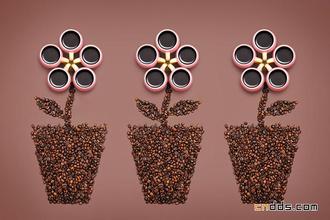Treatment of raw coffee beans-there are several ways to treat coffee fruits
Treatment of raw coffee beans-there are several ways to treat coffee fruits
The basic principle is to use the way of extrusion to squeeze out the soft ripe fruit of the seed, and the peeling machine needs to adjust the gap between the extrusion gap to avoid crushing the seed and destroying the endocarp, resulting in the infection of microorganisms in the follow-up process and making the coffee bean have a bad smell. but do not leave too much flesh, this part can use the speed of the peeling machine to cooperate with the seam adjustment of the fruit before entering the peeling machine It is best to carry out fruit size screening first, in order to adjust the space and speed of the peeling machine to suitable conditions, to get a consistent peeling effect to remove the pulp mucilage removal coffee raw bean treatment biochemical method-commonly known as fermentation process is the peeled coffee beans placed in the appropriate environmental conditions, the pectin contained in the pulp adhered to the inner pericarp is decomposed by lactic acid (lactic) fermentation, so that it is separated from the endocarp. After lactic acid fermentation to a certain extent, the secondary fermentation immediately after lactic acid fermentation, including acetic acid (acetic) fermentation, butyric acid (butyric) fermentation and rotting (putrid) fermentation, will lead to the decline of coffee quality, which should be avoided.
First pour the coffee beans into a large tank, and the poorly developed beans will float on the surface and pick up the ripe and full fruits that sink to the bottom of the water.
The tile is exposed to the sun, often flipped over, picking out defects.
When the water content in the coffee beans is reduced to 10%-14%, the peel pectin can be knocked off with a sheller, and the whole solarization method is complete.
Bean selection: first put the coffee fruit into the big water tank, move the red fruit and semi-green and semi-red fruit into the pulp sieving machine to remove the pulp and impurities.
Remove pectin: take out the coffee beans, do not need to take the sun, let alone pour into the sink to ferment, but directly into the next pectin scraper, only a small amount of water can scrape away the sticky pectin chips mechanically.
Sun exposure: then take out the raw beans with a smooth surface and expose them outdoors until the water content is reduced to 12%.

Important Notice :
前街咖啡 FrontStreet Coffee has moved to new addredd:
FrontStreet Coffee Address: 315,Donghua East Road,GuangZhou
Tel:020 38364473
- Prev

Introduction to the taste treatment method of flavor description in Ethiopian coffee origin and producing area
Ethiopian coffee origin characteristics flavor description taste treatment method A coffee tree usually takes about three to four years to grow before it begins to bear fruit, with red berries and a small number of yellow berries. After drying and removing the pulp, the coffee beans can be separated. There are shadows of coffee beans all over the world, and as long as the climate is right, it can grow as usual.
- Next

The treatment of Manning Coffee Bean in Indonesia introduction to the producing area of Grinding scale varieties in Manor
The Manor Grinding scale for the treatment of Manning Coffee beans in Indonesia the production area of the Manor Grinding scale is introduced. The reason why it can become one of its top Mantenin products and is famous in the world coffee world is that it adheres to the strictest quality management of La Minita, and the company specially sends people to Sumatra for technical guidance.
Related
- Detailed explanation of Jadeite planting Land in Panamanian Jadeite Manor introduction to the grading system of Jadeite competitive bidding, Red bid, Green bid and Rose Summer
- Story of Coffee planting in Brenka region of Costa Rica Stonehenge Manor anaerobic heavy honey treatment of flavor mouth
- What's on the barrel of Blue Mountain Coffee beans?
- Can American coffee also pull flowers? How to use hot American style to pull out a good-looking pattern?
- Can you make a cold extract with coffee beans? What is the right proportion for cold-extracted coffee formula?
- Indonesian PWN Gold Mandrine Coffee Origin Features Flavor How to Chong? Mandolin coffee is American.
- A brief introduction to the flavor characteristics of Brazilian yellow bourbon coffee beans
- What is the effect of different water quality on the flavor of cold-extracted coffee? What kind of water is best for brewing coffee?
- Why do you think of Rose Summer whenever you mention Panamanian coffee?
- Introduction to the characteristics of authentic blue mountain coffee bean producing areas? What is the CIB Coffee Authority in Jamaica?

